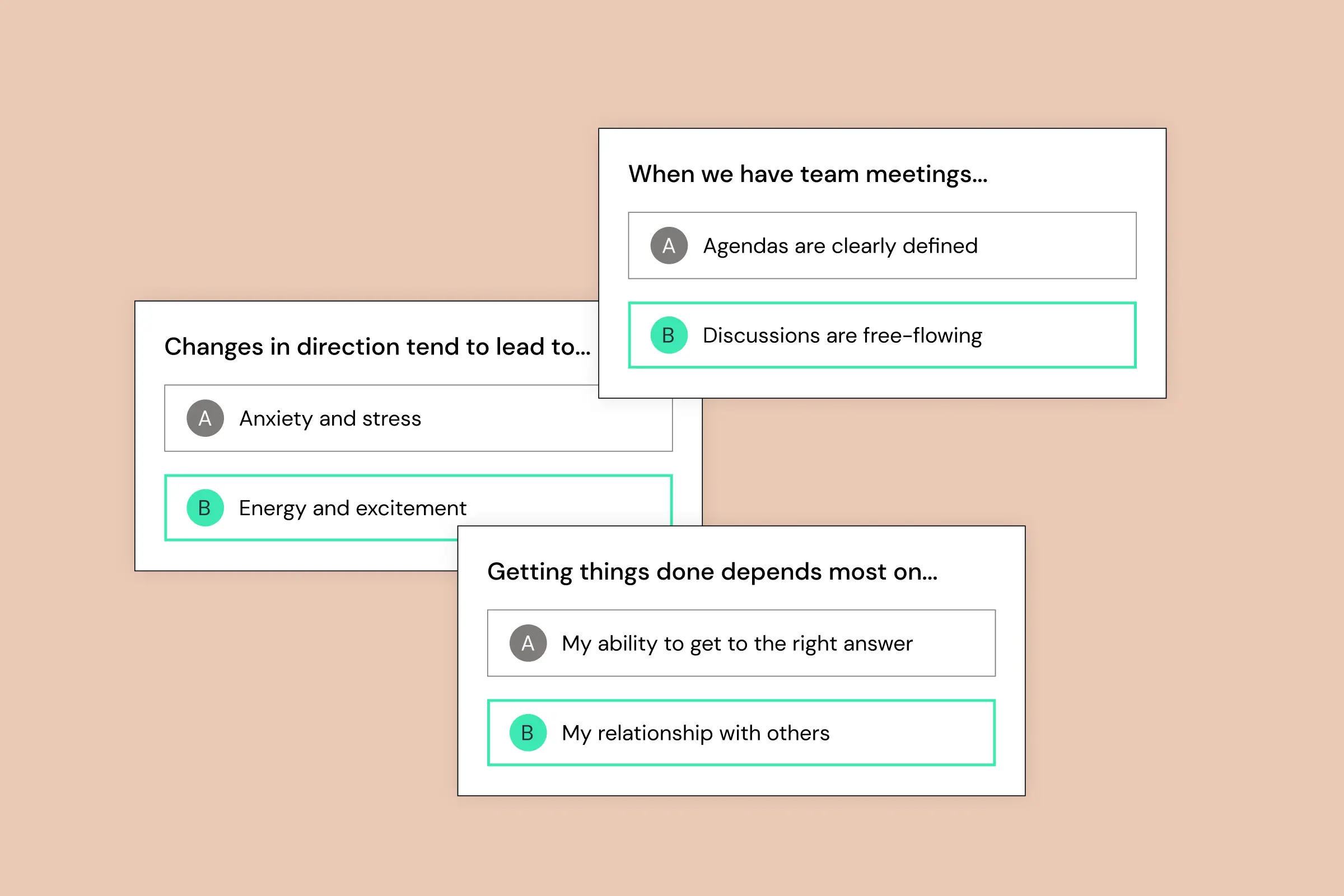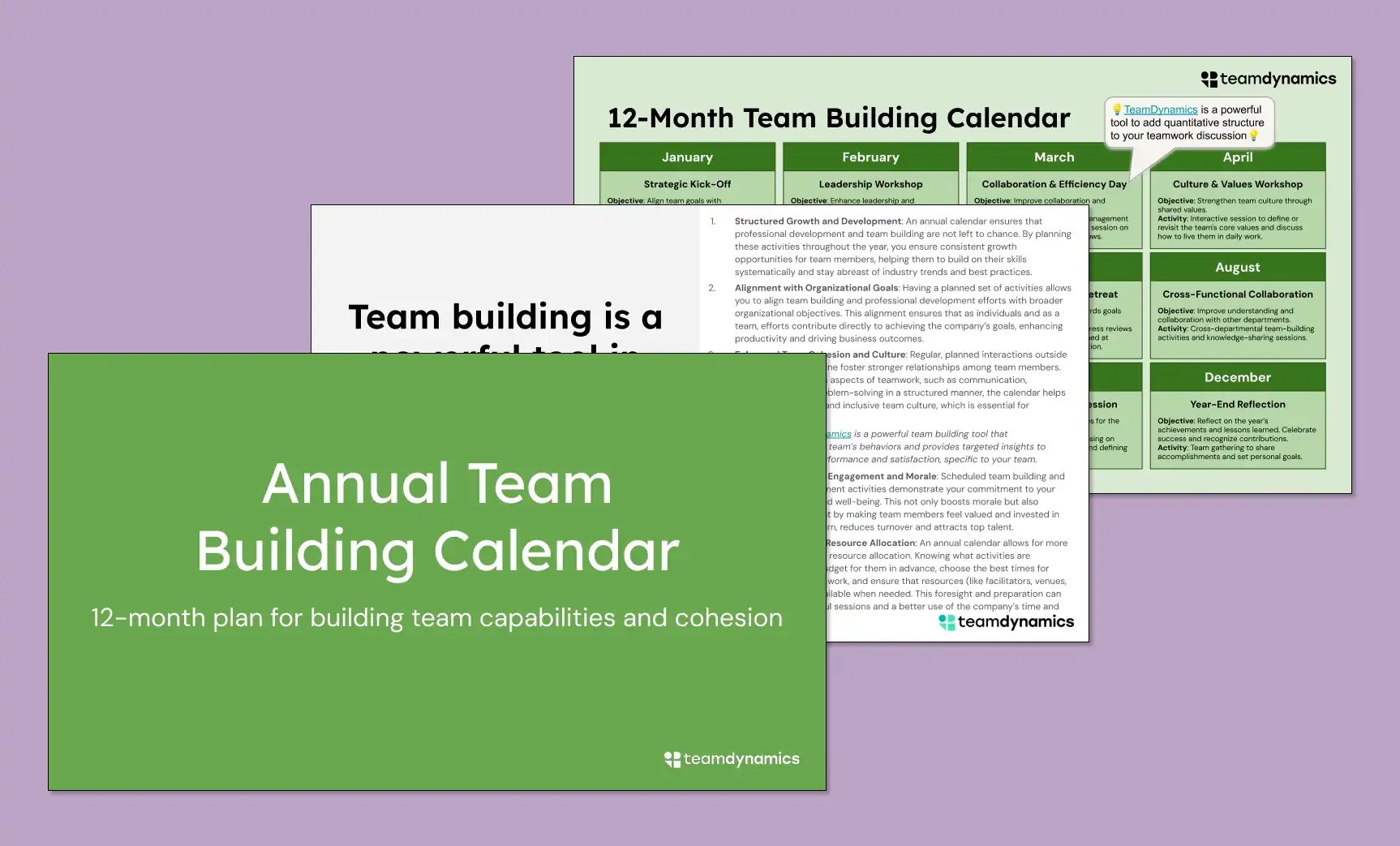Dealing with a micromanaging boss can feel like walking a tightrope. On one hand, you want to respect their authority and meet their expectations. On the other, constant scrutiny and an overbearing approach can drain your motivation, creativity, and overall job satisfaction. Micromanagement is more than just a minor annoyance—it can have serious consequences for both individual performance and team dynamics.
Understanding how to navigate this tricky situation is key to thriving in your role and advancing in your career. In this post, we’ll explore what micromanaging really means, why it’s a problem, and, most importantly, how you can effectively deal with a micromanaging boss. Whether you’re a team manager looking to improve your leadership skills or an individual contributor aiming to position yourself for growth, mastering this challenge is crucial.
As we explore this topic, we’ll also touch on how tools like TeamDynamics can help you gain deeper insights into your team and your manager’s behavior. This understanding can pave the way for better communication and collaboration, ultimately helping you navigate the complexities of a micromanaging boss with confidence.
{{inline-cta}}
Why Micromanaging is Harmful
Micromanaging isn’t just an irritating habit—it can have serious consequences for both individuals and the entire team. When a boss constantly hovers and controls every aspect of the work, it sends a clear message: “I don’t trust you to do your job well.” This lack of trust can lead to a host of negative effects that ripple through the workplace.
1. Decreased Morale and Motivation
When employees feel that their every move is being watched, their morale takes a hit. The lack of autonomy makes people feel less valued and more like cogs in a machine rather than skilled professionals. Over time, this can lead to decreased motivation, as employees start to question their competence and purpose within the team.
2. Stifled Creativity and Innovation
Micromanaging also stifles creativity. When every decision has to go through the boss, there’s little room for employees to experiment, take risks, or offer new ideas. This can prevent the team from finding innovative solutions or improving processes. In a workplace where micromanagement is the norm, “thinking outside the box” becomes nearly impossible.
3. Increased Stress and Burnout
The constant pressure of being closely monitored can lead to significant stress. Employees might feel like they’re always on edge, worried about making even the smallest mistake. Over time, this stress can accumulate, leading to burnout. A micromanaging boss can turn what should be a healthy, collaborative work environment into a high-pressure, anxiety-inducing space.
4. Lower Productivity
Ironically, the very behavior intended to increase control and efficiency often has the opposite effect. When employees are micromanaged, they spend more time getting approvals and making sure every detail aligns with their boss’s expectations rather than focusing on completing tasks. This slows down the workflow and reduces overall productivity.
5. High Turnover Rates
Employees who feel stifled by a micromanaging boss are more likely to leave the company. High turnover rates not only disrupt the team but also incur significant costs in terms of hiring and training new employees. In the long run, micromanagement can lead to a revolving door of talent, weakening the team’s cohesion and effectiveness.
Micromanagement isn't the only example of bad team dynamics. Learn to recognize the signs of a team in trouble with our list of bad team dynamics at work.
Understanding the harmful effects of micromanagement is crucial for both employees and managers. Recognizing these impacts can be the first step toward making positive changes in your work environment. In the next section, we’ll explore practical strategies for dealing with a micromanaging boss, helping you navigate this challenge effectively.
How to Identify a Micromanaging Boss: Micromanaging Examples
Before you can effectively deal with a micromanaging boss, you need to be able to recognize the signs. Micromanagement can sometimes be subtle, blending into normal supervisory practices, but there are distinct behaviors that set it apart. Here’s how you can identify whether your boss is crossing the line into micromanagement.
Dealing with a micromanaging colleague? Check out our guide to 10 common challenges with coworkers (and what to do about them!).
1. Constant Check-Ins
If your boss frequently asks for updates on your work, even when there’s no new information to share, this is a classic sign of micromanagement. These check-ins might happen multiple times a day, disrupting your workflow and adding unnecessary stress.
Example of Micromanaging: You’ve just started working on a new project, and your boss asks for updates every hour, even though there’s little to report. They might pop by your desk frequently or send multiple emails throughout the day, asking for status updates on tasks that don’t require such close monitoring. This constant oversight interrupts your workflow and creates unnecessary stress, a hallmark of micromanagement.
2. Lack of Delegation
Micromanaging bosses often have a hard time letting go of tasks. They might insist on handling even minor details themselves rather than delegating responsibilities to their team. If your boss is reluctant to assign tasks without hovering over every step, they’re likely micromanaging.
Example of Micromanaging: You’ve offered to take on a portion of a project, but your boss insists on handling even the smallest tasks themselves. For instance, they might refuse to let you draft a simple email, instead preferring to write it themselves. This behavior shows a reluctance to delegate, indicating that they don’t trust you—or anyone else on the team—to handle responsibilities independently.
3. Obsessive Attention to Detail
While attention to detail can be a positive trait, a micromanaging boss takes it to the extreme. They might focus on trivial aspects of a project, such as the formatting of a document or the specific wording in an email, instead of trusting you to make these decisions on your own.
Example of Micromanaging: You submit a report that meets all the requirements, but your boss sends it back with numerous comments on minor details, like the font size or the specific wording of a sentence. They might spend an inordinate amount of time nitpicking over things that don’t impact the overall quality of the work. This obsessive focus on trivial details is a clear sign of micromanagement.
4. Frequent Corrections
Even when your work is correct, a micromanaging boss might frequently make unnecessary corrections or insist on redoing tasks to match their exact preferences. This can be frustrating and demoralizing, especially when the changes don’t improve the final product.
Example of Micromanaging: Even when your work is perfectly fine, your boss frequently offers corrections or insists on redoing tasks to match their exact preferences. For example, after you’ve followed the project guidelines, they still ask you to revise the document multiple times, making minor changes that don’t significantly improve the outcome. This behavior can be frustrating and demoralizing, as it undermines your confidence in your own abilities.
5. Involvement in Every Decision
A micromanaging boss often wants to be involved in every decision, no matter how small. They might override your choices or require approval for even the simplest tasks, leaving you little room to make independent decisions.
Example of Micromanaging: You’re working on a project that you’ve handled successfully many times before, but your boss insists on being involved in every decision, no matter how small. They might require approval for every step of the process, from selecting the color scheme for a presentation to choosing the meeting agenda. This level of involvement leaves little room for you to make independent decisions, which is a strong indicator of micromanagement.
6. Lack of Trust
At the core of micromanagement is a lack of trust. If your boss questions your ability to complete tasks without their constant oversight, it’s a clear sign that they don’t have confidence in your skills. This lack of trust can erode your confidence and make it difficult to perform at your best.
Example of Micromanaging: You’ve been working in your role for years and have a proven track record of success, but your boss still questions your ability to complete tasks without their oversight. They might second-guess your decisions or frequently ask for reassurance that you’re on the right track, despite your experience. This lack of trust can erode your confidence and make it difficult to perform at your best.
Identifying these behaviors is crucial for addressing the issue. Once you recognize that your boss is micromanaging, you can start taking steps to improve the situation. In the next section, we’ll discuss strategies for dealing with a micromanaging boss, helping you regain control of your work environment and build a more productive relationship.
Strategies to Deal with a Micromanaging Boss
Once you’ve identified that your boss is a micromanager, the next step is figuring out how to manage the situation effectively. It’s important to strike a balance between addressing the issue and maintaining a positive working relationship. Here are some practical strategies to help you deal with a micromanaging boss.
1. Set Clear Expectations
One of the best ways to manage a micromanaging boss is by setting clear expectations from the start. During project discussions, clarify what needs to be done, the deadlines, and the level of detail they expect in your updates. By being proactive, you can reduce the need for constant check-ins and give your boss confidence in your ability to manage your responsibilities.
Example Application: You’ve just been assigned a new project, and your boss starts asking for updates every hour. To manage this, you could proactively suggest a schedule for updates, setting expectations for when they can expect to hear from you. By doing this, you reduce the frequency of interruptions and give your boss confidence that the project is on track.
Suggested Phrases to Try:
- “To ensure we’re aligned, I’d like to clarify the goals and deadlines for this project. Is it okay if I provide updates at these specific points?”
- “I’ll handle these tasks and send you a detailed update by [specific time]. Does that work for you?”
2. Build Trust Through Communication
Trust is the foundation of any strong working relationship. To alleviate your boss’s need to micromanage, focus on building trust. Regularly update them on your progress, even before they ask. By consistently delivering high-quality work and being transparent about your process, you can gradually reduce their need to hover over you.
Example Application: If you’ve noticed that your boss becomes particularly anxious as deadlines approach, you can alleviate this by sending brief, regular updates before they even ask. This preemptive communication shows that you’re on top of things, helping to build their trust and reducing their need to micromanage.
Suggested Phrases to Try:
- “I wanted to give you a quick update on my progress so far. Here’s what I’ve completed and what’s coming next.”
- “If there’s anything specific you’d like me to focus on, please let me know so I can prioritize it.”
3. Ask for Feedback and Listen
Engage your boss in a constructive dialogue about your work. Ask for feedback and be open to their suggestions. This can help you understand their expectations and adjust your approach accordingly. When they see that you’re taking their feedback seriously, they may feel less inclined to micromanage.
Example Application: After completing a significant portion of a project, you might ask your boss for their thoughts on your work. This not only shows that you value their input but also opens the door for constructive dialogue. Over time, they may become more comfortable giving you more freedom as they see that you’re receptive to their feedback.
Suggested Phrases to Try:
- “I’d appreciate your feedback on this approach. Do you see any areas where I could improve?”
- “How do you feel about the progress so far? Is there anything you’d like to adjust?”
4. Be Proactive About Solutions
If you notice that certain tasks or projects trigger your boss’s micromanaging tendencies, take the initiative to propose solutions. For example, if they’re particularly focused on a specific part of a project, offer to provide detailed updates on that aspect while handling the rest more independently. This approach shows that you’re taking their concerns seriously while also demonstrating your ability to manage other areas on your own.
Example Application: If your boss consistently micromanages a particular part of a project, such as the presentation format, you could suggest taking charge of that area while keeping them updated on your progress. This approach demonstrates initiative and shows that you’re mindful of their concerns, while also setting boundaries on the level of oversight.
Suggested Phrases to Try:
- “I’ve noticed you’re very involved in [specific aspect]. Would it help if I provided detailed updates on that while handling the rest more independently?”
- “To streamline the process, I’d like to propose [specific solution]. What do you think?”
5. Set Boundaries Politely
Sometimes, you may need to set boundaries to ensure you can work effectively. This can be tricky, but it’s essential for maintaining your productivity and sanity. For example, if your boss is constantly checking in during the day, you might say, “I’ll be focusing on this task for the next few hours and will send you an update by [specific time].” This approach communicates that you’re on top of things while also giving you the space to work uninterrupted.
Example Application: When your boss frequently interrupts your workflow with questions or requests, politely setting boundaries can help maintain your productivity. For example, if you’re working on a critical task, you might let them know that you’ll be unavailable for a certain period but will check in afterward. This approach allows you to focus on your work without completely cutting off communication.
Suggested Phrases to Try:
- “I’m planning to focus on this task for the next few hours and will provide you with an update afterward. Is that okay?”
- “To stay focused, I’ll be working on this without interruptions and will check in with you at [specific time]. Does that work?”
6. Frame Conversations Strategically
When discussing your concerns with a micromanaging boss, it’s important to be tactful. Focus on how certain behaviors are affecting your work and suggest alternatives that could benefit both of you. For instance, you might say, “I’ve noticed that when we review every detail together, it can slow down the process. I’d like to suggest that I handle these smaller tasks independently and provide a summary at the end.”
Example Application: If your boss’s micromanagement is slowing down a project, you could suggest a shift in focus during your next check-in. By framing the conversation around efficiency and the overall success of the project, you can encourage your boss to delegate more responsibilities to you.
Suggested Phrases to Try:
- “I’ve noticed that when we go over every detail together, it can slow down the process. Could we try delegating some of these decisions to speed things up?”
- “I think we could save time by focusing on the big picture. How do you feel about me handling the details on my own?”
7. Highlight the Benefits of a More Autonomous Approach
Sometimes, reminding your boss of the benefits of giving you more autonomy can help shift their mindset. Explain how having more independence will allow you to be more efficient and deliver better results. Emphasize that by focusing on the bigger picture, they can help the team achieve its goals more effectively.
Example Application: During a performance review or project meeting, you could propose a more autonomous approach by highlighting how it would benefit both you and the team. For instance, if you’ve demonstrated strong performance in the past, use that as a basis to request more independence in your current role.
Suggested Phrases to Try:
- “I believe that having more autonomy will allow me to be more efficient and deliver better results. I’d love to discuss how we can make that happen.”
- “By focusing on the overall strategy, I think we can achieve our goals more effectively. I can handle the smaller details independently if that’s okay with you.”
8. Use TeamDynamics to Understand and Improve Communication
Understanding your boss’s management style and how it fits with the team’s dynamics can be crucial in managing micromanagement. Tools like TeamDynamics can provide insights into how your boss prefers to communicate and make decisions. By understanding these preferences, you can tailor your communication and collaboration approach to reduce friction and build a more productive working relationship.
Example Application: If you’re struggling with ongoing micromanagement, suggesting the use of TeamDynamics could be a strategic move. For example, if you’re in a team meeting discussing workflow issues, you could bring up how TeamDynamics might help the team—and the boss—gain insights into communication styles and preferences, making it easier to work together more effectively.
Suggested Phrases to Try:
- “I’ve been thinking about how our team communicates and how we can work more effectively together. Have you heard of TeamDynamics? It might give us some useful insights.”
- “I believe using a tool like TeamDynamics could help us understand our working styles better and reduce the need for constant check-ins.”
Dealing with a micromanaging boss isn’t easy, but with the right strategies, you can improve the situation. By setting clear expectations, building trust, and using tools like TeamDynamics to better understand your team and your manager, you can create a more positive and productive work environment.
How TeamDynamics Can Help You Deal With a Micromanaging Boss
Navigating the complexities of working with a micromanaging boss requires more than just good communication skills—it also requires a deep understanding of team dynamics. This is where a tool like TeamDynamics can make a significant difference. By providing insights into how your team and manager operate, TeamDynamics can help you better communicate, collaborate, and ultimately reduce the friction caused by micromanagement.
1. Understand Your Manager’s Communication Style
One of the key benefits of TeamDynamics is its ability to reveal how different team members, including your boss, prefer to communicate. Some managers micromanage because they have a specific communication style that isn’t aligned with the team’s. For instance, if your boss prefers frequent, detailed updates and you’re more independent, this mismatch can lead to micromanagement.
Suggested Approach:
- Use TeamDynamics to identify your boss’s preferred communication style.
- Adjust your approach to match their preferences. For example, if they value frequent updates, make it a habit to proactively share your progress.
Example Application: After using TeamDynamics, you discover that your boss prefers a structured, detail-oriented communication style. By adapting your updates to include more detail and regular check-ins, you can preemptively address their concerns, reducing the need for them to micromanage.
2. Foster Better Team Collaboration
Micromanaging often occurs when there’s a lack of collaboration or trust within the team. TeamDynamics can help pinpoint where communication or collaboration is breaking down, allowing you to address these issues directly. By improving team cohesion, you can help reduce the need for your boss to oversee every aspect of the work.
Suggested Approach:
- Use TeamDynamics to identify areas where team collaboration could improve.
- Propose changes to how the team communicates and collaborates, based on the insights gained.
Example Application: TeamDynamics reveals that communication within your team is siloed, leading to frequent misunderstandings and missed deadlines. You could use this information to propose more regular team check-ins or collaborative tools, improving overall teamwork and reducing the boss’s need to micromanage.
3. Improve Your Own Working Style and Adaptability
Understanding your own working style through TeamDynamics can also help you adapt to a micromanaging boss. By recognizing how your preferences align or clash with your boss’s management style, you can take proactive steps to adjust your behavior, making it easier to work together.
Suggested Approach:
- Reflect on your TeamDynamics profile to identify areas where you might need to adapt your working style.
- Implement changes in your workflow or communication to better align with your boss’s expectations.
Example Application: If your TeamDynamics profile shows that you prefer a hands-off approach but your boss is more hands-on, you could adjust by offering more frequent updates and seeking feedback earlier in the process. This demonstrates your willingness to meet them halfway, potentially easing their need to micromanage.
4. Create a More Productive and Harmonious Work Environment
Ultimately, the goal of using TeamDynamics is to create a more productive and harmonious work environment. By understanding the dynamics at play, you can address the root causes of micromanagement, leading to a more autonomous and efficient team. This not only benefits you but also helps your boss focus on the bigger picture rather than getting bogged down in the details.
Suggested Approach:
- Use the insights from TeamDynamics to propose team-wide changes that foster a more positive work environment.
- Encourage your boss to use TeamDynamics to better understand and manage the team’s dynamics.
Example Application: After implementing changes based on TeamDynamics insights, your team begins to function more smoothly, with fewer misunderstandings and a clearer division of responsibilities. Your boss notices the improvement and starts to step back, allowing the team to operate with more independence.
By leveraging the insights provided by TeamDynamics, you can gain a deeper understanding of both your team and your manager’s behaviors. This knowledge empowers you to make informed decisions, communicate more effectively, and ultimately reduce the impact of micromanagement on your work environment.
Conclusion
Dealing with a micromanaging boss is a challenge that many professionals face at some point in their careers. While it can be frustrating and demoralizing, understanding how to navigate this situation effectively can make all the difference. By recognizing the signs of micromanagement and applying the strategies we’ve discussed, you can take control of your work environment and build a more positive, productive relationship with your boss.
Setting clear expectations, building trust through proactive communication, and framing conversations carefully are all essential steps in managing a micromanaging boss. It’s also important to be proactive in proposing solutions and setting boundaries politely, ensuring that you can work efficiently while meeting your boss’s needs.
Additionally, tools like TeamDynamics can provide valuable insights into your team’s dynamics and your manager’s communication and decision-making style. By understanding these factors, you can tailor your approach to better align with your boss’s expectations, reducing the likelihood of micromanagement and fostering a more collaborative work environment.
Remember, the goal is not just to survive under a micromanaging boss but to thrive by improving the overall dynamics within your team. With the right strategies and tools, you can turn this challenge into an opportunity for growth, both for yourself and your team.
If you’re struggling with a micromanaging boss, consider how TeamDynamics could help you better understand your team and your manager. By gaining deeper insights into your work environment, you can take meaningful steps toward improving communication, collaboration, and overall team performance. Try TeamDynamics for free and see if it can help your team!




.png)






































